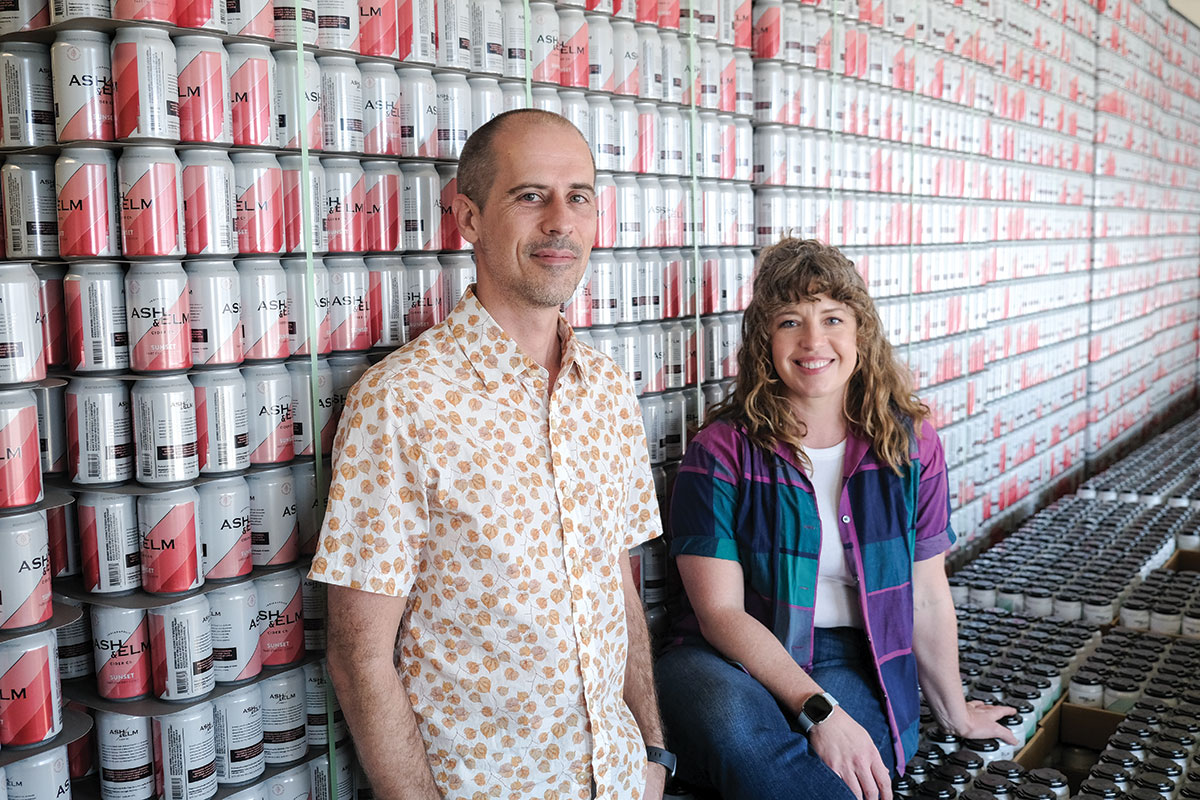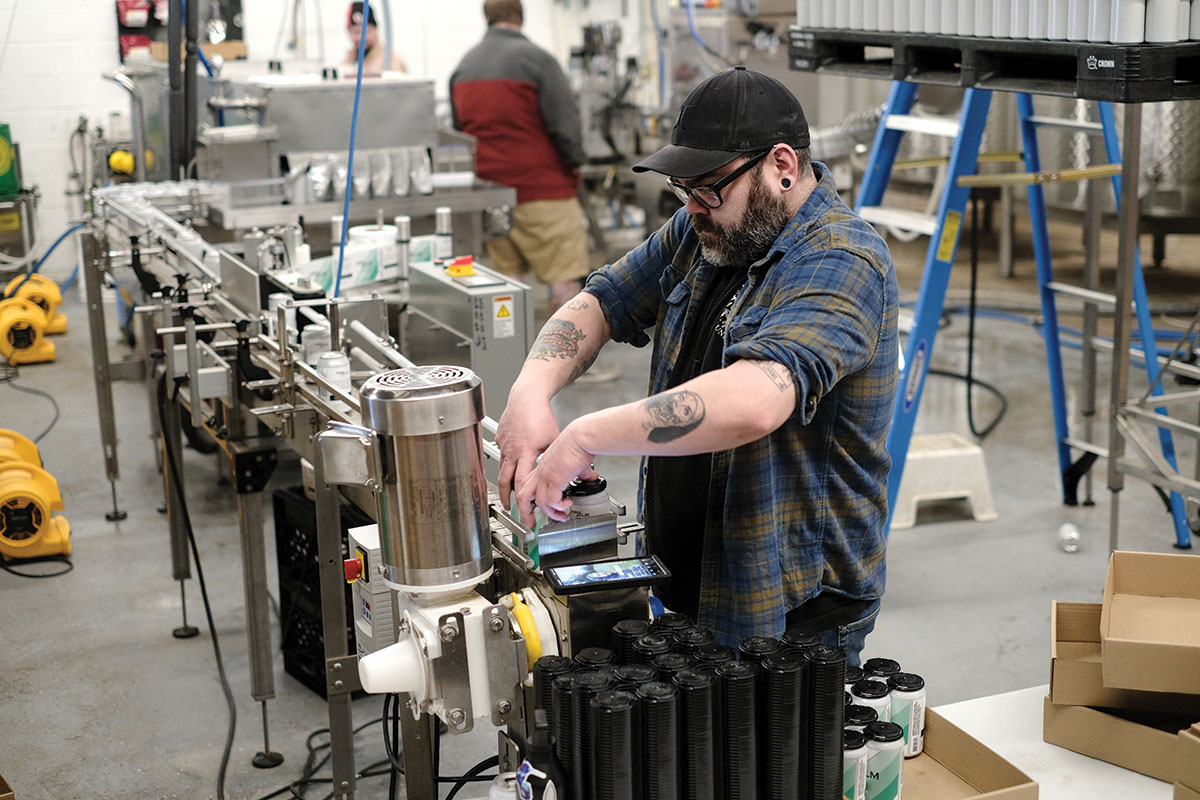Subscriber Benefit
As a subscriber you can listen to articles at work, in the car, or while you work out. Subscribe Now
The pandemic’s travails helped make Indianapolis-based Ash & Elm Cider Co. what it is today—one of the nation’s largest regional alcoholic cider producers, with what will soon be two restaurants and a statewide retail distribution network that has placed its beverages in almost every Kroger in Indiana and at many other outlets.
Its owners say the company is just getting started, with plans to expand its retail business to neighboring states and grow its online cider club into the nation’s biggest.
“In five years, I want us to be a regional cider brand with a large national customer base that we ship to,” said Andrea Homoya, co-founder and CEO. “And I want to raise our national profile. We’re already in the top 5% of cider producers nationally, but no one seems to hear about us in little old Indiana.”
The company started in 2016, after Andrea and her husband, co-founder and Chief Financial Officer Aaron Homoya, visited Ireland and tasted old-school ciders carefully derived from locally grown apples specially raised for the purpose. The clean, somewhat dry taste, with flavor notes reminiscent of fine wines, intrigued Aaron, who was already a wine and beer maker.
“It was the first time I’d ever had anything like that,” he said. “It was made completely from apples, and it was very complex, and it just kind of blew my mind.”
Aaron started working with cider when the couple returned from Europe. His interest in the product proved timely, as Andrea was mulling over what sort of business they could start together.
“We went through our list of ideas and really felt like this one was the best combination of personal interest and market opportunity,” he said.
Ultimately, though, it was the challenges posed by the pandemic combined with a growing demand for regional ciders that created the company’s big growth.
When the company outgrew its original 800-square-foot retail space next to its production facility at 2112 E. Washington St. in 2020, the Homoyas broke ground on a combined restaurant/retail location at 1301 E. Washington St.
“I remember we had an all-staff meeting in January of that year, and I was like, ‘OK, everybody, our word for the year is Dominate.’”
However, COVID changed the word for the year to “Survive.” Storefront sales ended, the restaurant was put on hold, and most of the company’s staff was furloughed. Which left the Homoyas rattling around their production facility, trying to figure out a way forward.

Alternatives
Fortunately for them, they soon found a path. They were able to postpone construction of the restaurant and instead focused on something Andrea had been thinking about for a while.
She’d just gone live with an online “cider club” mail-order platform, which shipped Ash & Elm products across the country. The couple leaned into it and discovered both a non-trivial revenue stream and a much-needed morale boost.
“Every night, so many people that I hadn’t seen or talked to since high school or college would place orders,” Andrea recalled. “I would go in and package those online orders myself because we had furloughed everyone. I would see the names of Aaron’s high school friends and my college teachers from throughout the U.S. I was pregnant and very emotional at the time, and I would just cry and pack boxes.”
She also started another, even more helpful, strategy—selling at farmers markets.
“We sold so much,” Andrea said. “It was everything you’d want in a small business. We were talking directly to our customers, educating them about cider, and it was relatively easy. We just needed a pop-up tent and a cooler. We made about $25,000 just from going to the Carmel farmers market every Saturday in the summer, which was like a month of our retail sales at the time.”
The extra cash helped the Homoyas weather COVID, and the segment remains profitable today. Ash & Elm attends around 10 farmers markets every weekend during the warm months throughout the state.
During the pandemic, the couple also initiated what has perhaps been their biggest strategy win—an increased emphasis on grocery sales.
“All the bars and restaurants were closed during COVID, but grocery stores were still open,” Aaron said. “We saw success in that area throughout the pandemic, which shifted our priorities into trying to get into chain stores across the state and pushing our distribution growth a lot more than we had before.”
Ash & Elm finally opened its long-deferred restaurant in August 2021 and is in the process of opening a second in Carmel. The company plans, over the next few years, to expand retail distribution outside Indiana, both through the Cider of the Month online club (one of the largest such programs in the country) and by winning more space in stores and restaurants.
Off-premises sales have been a big growth area for a lot of cider companies in recent years, according to the American Cider Association.
Tasting Table, a news site for food and drink enthusiasts, recently reported that total U.S. cider revenue hit a whopping $553.6 million in 2021, up from $517.8 million in 2019.
Revenue growth at Ash & Elm has been even more dramatic, hitting $2.5 million last year on 94% annual growth over the past three years.

Ash & Elm also was among the first regional cider companies in Indiana, becoming a dominant state force in a fairly wide-open market. The situation hasn’t changed much. While there are currently 1,200 to 1,300 regional cider producers nationwide, only around 19 call Indiana home, according to information provided by Michelle McGrath, CEO of the American Cider Association.
ACA statistics show, until fairly recently, a steady increase in sales for regional brands in Indiana, rising from $947,103 in 2019 to $1,588,389 in 2023. These numbers for “regional” products include not just Indiana-based cider makers, but other small U.S. manufacturers who sell product in the Hoosier state. According to the ACA’s most recent numbers, Indiana’s regional cider sales have fallen 7.7% year-over-year. However, that may not be as bad as it sounds, because much of the decline appears to have been borne by out-of-state brands.
“It appears that Indiana brands are a bright spot in that regional brand decline,” McGrath said. “Indiana may be owning more of the regional market share in its backyard.”
An art and a science
Cider production, according to Aaron Homoya, can present some hassles that beer and wine producers don’t face. For instance, the product typically has a relatively low alcohol content, leaving it vulnerable to bacteria, which can “skunk” an entire batch. And unlike beer, the components of which are brought to a bug-killing boil before fermentation, it’s never heated.
It’s also tough to make one batch of apple-only cider taste exactly like the next. There are simply too many factors in play.
“With beer recipes, if you carefully replicate them and track the process, it will turn out the same every time,” Aaron said. “But cider is much more like wine. The flavor is based on each harvest. So if we want to make a product that’s consistent, there’s much more refining throughout the process. It’s more of an art and also more of a science.”
Though Ash & Elm indeed makes some of the old-school, European-style ciders that got the Homoyas interested in the field, its real bread and butter are the “flavored” varieties.
“In the cider industry, it’s called being a modern cider maker,” Andrea said. “And we’re a totally modern cider maker. We do not have problems with adding fruits or spices or hops or other ingredients and using our cider base as a blank canvas to bring out beverages that can take on those flavors very well.”
The company’s extensive product lineup includes Obscura Blackberry Cider, Autumntide Spiced Pumpkin and Del Camino Pineapple.
“We experiment with different flavors constantly, and I think that’s what our local customer base loves about us and what keeps them coming back to us,” Aaron said.
One of Ash & Elm’s top sellers is a raspberry/lemon cider named Fleeting Youth.
“It’s the one that’s taken off the most,” Aaron said. “It’s always been a big seller for us in local bars and restaurants, but it’s also taken off in grocery stores and liquor stores and has kind of become what people seek us out for.”
Old-school ciders are far less numerous, in part because they’re something of an acquired taste and also because it can be tough to find the proper ingredients. High-brow ciders, like high-brow wines, often use apple varieties that are very, very different from the sorts typically seen in grocery stores (and Indiana orchards). They’re often high in tannin, not ridiculously sweet and hard to find in the United States.

A local ecosystem
In the long run, the Homoyas would love to help establish a cider-making ecosystem in Indiana, complete with orchards that produce for the industry. But that hasn’t happened yet—at least on any appreciable scale. So for now, they primarily use out-of-state apple juice—roughly 3-1/2 million apples’ worth annually, which they use to create 7,000 to 8,000 gallons of cider per month.
“We get our apples from Michigan almost exclusively,” Aaron said. “Every once in a while, we’ll get them from an Indiana orchard that we collaborate with, but the orchards here don’t have quite the scale we need. After they fulfill orders for apples from traditional customers, they don’t have a lot of extra for us.”
McGrath of the cider association said states that provide the most apples for cider production include Pennsylvania, New York, Washington, California, Oregon and Michigan. “Indiana is definitely coming to the party late,” she said.
The Homoyas hope Ash & Elm’s increasing size and profile might help change that. It might be a nice overarching goal to accompany the company’s more mercantile concerns, such as goosing distribution and fulfilling Andrea’s desire to make the company’s cider club the largest in the country.
“I love a big goal, and usually if I make one, I get it,” she said.•
Please enable JavaScript to view this content.

